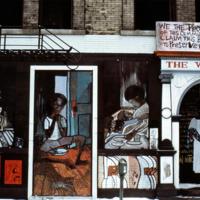
Wall of Truth
Although sharing an address with the famous Wall of Respect, the Wall of Truth was different. Whilst the Wall of Respect exalted black role models, leaders and liberators, the Wall of Truth wove negative scenes of poverty, brutality and racism into the fabric of the urban environment. Rather than promoting racial pride, it highlighted racial disparities. “The intent on the opposite side [of the road] was that things had gone more militant,” muralist Eugene Wade explained: “more blackness was needed in terms of representing the Black Power symbol and the whole thrust of what was happening in the black community.” Wade notes that “people were getting angry and fed up, so what we were trying to do was implement the attitude and the mood."The Wall of Truth was a significantly larger mural than its Chicago neighbour, the Wall of Respect. It spanned the length of an apartment building, and wrapped around onto an adjoining wall. It contained nine separate narrative panels and was one of the first instances that a radical black past was visualised in the streets through the antislavery leaders Frederick Douglass and Nathaniel Turner, as well as Mary McLeod Bethune, W.E.B. Du Bois, H. Rap Brown, Stokely Carmichael, Marcus Garvey, Huey P. Newton, Fred Hampton, and Malcolm X.
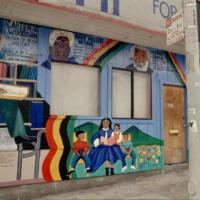
Scenes from the Bayview Opera House
Painted in 1995 in San Francisco by artist Leboriae P. Smoore, this mural acts as a children’s textbook in the street, teaching about the antislavery leaders Harriet Tubman and Frederick Douglass, and other black figures: Carter G. Woodson, Mary McLeod Bethune, W.E.B. Du Bois, Ida B. Wells, and Jackie Robinson.
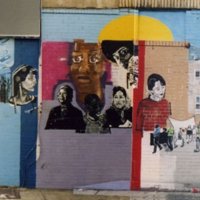
Women Warriors
In 2001, Brooklyn-based muralist Leola Bermanzohn created a mural in the Flatbush area of Brooklyn titled Women Warriors. Bermanzohn works as a muralist for the Groundswell organisation, launched in 1996 with the mission of bringing together artists, youth and community organisations to create murals that beautify local neighbourhoods and give expression to underrepresented ideas and perspectives. Women Warriors was created in collaboration with Sister Outsider – an organisation run by and for women of colour that aimed to help women enter the professional world of work and operate in the political realm. The mural was at the organisation’s headquarters and depicted antislavery leaders Harriet Tubman and Sojourner Truth as well as Nefertiti, Rosa Parks and Assata Shakur, alongside a poem written by Audre Lorde. It had been destroyed by 2015.
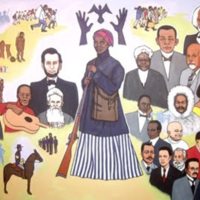
From Africa to America
Wilfred R. Stroud created this seven-panel mural in 1988 to be installed on the first floor of the Tubman Museum. It remains a signature piece in the Museum’s collection today. When the mural was being created, Stroud expained: “The purpose of this mural is to present a visual history of the black man and woman from the earliest times in Africa to the present times in America. The panels focus attention upon the impact of outstanding persons, and events that made a change in the lives and conditions of black people in particular, and the world in general.” Stroud dedicated an entire panel to the topic of slavery. Harriet Tubman stands in the centre, holding a rifle and surrounded by other antislavery leaders: Sojourner Truth, Abraham Lincoln, Frederick Douglass and John Brown.
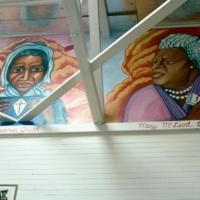
The Great Cloud of Witnesses
In 1992, Selma Brown, Susan Cervantes and Ronnie Goodman painted images of the antislavery leaderes Sojourner Truth, Harriet Tubman and Frederick Douglass, as well as Mary McLeod Bethune, W.E.B. Du Bois, and Thurgood Marshall, at Ingleside Presbyterian Church and Community Center in San Francisco, California. The mural, titled The Great Cloud of Witnesses, was started by Revered G. when he pasted a single newspaper clipping of his hero, Muhammad Ali to the wall of the church gymnasium in 1980. Over the decades, the collage expanded to cover the entire gym, fellowship hall, stairways, hallways, bathrooms, basement and meeting rooms. The mural is multi-faceted and contains newspapers, magazine clippings, photographs, flyers, posters, prints, poetry and painted murals.
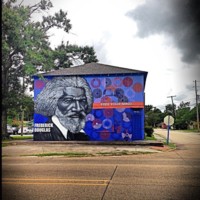
Free Your Mind
In 2013, Rahmann Statik painted two murals on the sides of a building in Beauregard Town, Baton Rouge. The murals cover the entirety of the building’s façade and reads, “Free Your Mind” alongside an image of Frederick Douglass, whilst the likeness of Harriet Tubman decorates the other side of the wall. Statik grew up on the southside of Chicago, surrounded by murals, and trained at the American Academy of Arts before working with Gallery 37 to teach mural creation to children. As of 2014, the mural no longer exists.
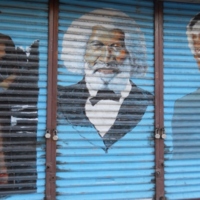
Tubman, Douglass, Mandela
This mural was created in 2008 by an unknown artist. Painted on a storefront on Ralph Avenue in Brooklyn, it depicted Harriet Tubman, Frederick Douglass and Nelson Mandela. As of 2014, it no longer existed.
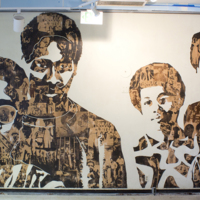
The Black Experience
In 1970, a group of seven black UCLA art students created a mural titled The Black Experience on the first floor of the Ackerman Student Union building. The mural, which measures 10 feet by 27 feet, was obscured for 20 years by a false wall erected in front of it during building renovations in 1992. Then in 2013, the mural was restored. “It was important in 1970, as it is today, to address issues of racial disparity on the UCLA campus,” one of the artists, Helen Singleton said. “Our mission in creating ‘The Black Experience’ mural was to expand and enhance that effort with a visual representation of the history and experience of African Americans in the United States.” The seven art students, Helen Singleton, Marian Brown, Neville Garrick, Andrea Hill, Jane Staulz, Joanne Stewart and Michael Taylor, are all depicted in the mural, alongside silk-screened graphics of the antislavery leaders Frederick Douglass and Harriet Tubman, alongside Martin Luther King Jr., Malcolm X, Bobby Seale, Huey P. Newton, Muhammad Ali, and Angela Davis. “We learned a lot about our history by exploring what images to use,” said Garrick, who was a freshman from Jamaica when he participated in the art project. In 2012, the effort to uncover the mural gained momentum after members of the Afrikan Student Union brought the mural to the attention of the Associated Students UCLA board of directors. At the unveiling in 2013, both Singleton and Garrick were guests of honour, along with activist Angela Davis.
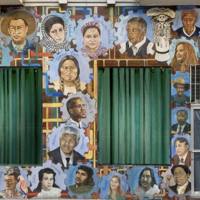
La L.ucha Continua/The Struggle Continues
This mural was painted on 3260 23rd St, between Mission and Capp Streets, in San Francisco by Susan Caruso Green, and was a community collaboration between muralists and local residents. It brings together faces from global history who have fought for civil rights, including the antislavery leader Harriet Tubman, Nelson Mandela, Gandhi, Mumia Abu-Jamal, Malcolm X, and Martin Luther King Jr.
![Leroy White, Wall of Respect, Up You Mighty Race, Leffingwell & Franklin Aves, St. Louis MO, 1968 [destroyed 1980s].jpg Leroy White, Wall of Respect, Up You Mighty Race, Leffingwell & Franklin Aves, St. Louis MO, 1968 [destroyed 1980s].jpg](https://486312.frmmmguz.asia/files/square_thumbnails/ccbe25581b885dd6ea7ad25405af90fe.jpg)
Wall of Respect/Up You Mighty Race
In 1968, after the success of Chicago’s Wall of Respect in 1967, muralist Leroy White painted Wall of Respect/Up You Mighty Race in St. Louis, Missouri. The mural was self-sponsored. After seeing Chicago’s Wall of Respect in Ebony, muralists in St. Louis were inspired to create public art in the Carr Square area of the city. The mural was completed by a coalition of individuals from civil rights groups, including CORE, ACTION, and the Zulu 1200s. It displayed a pantheon of black heroes, including the antislavery leaders Frederick Douglass, Malcolm X, Martin Luther King Jr., and Marcus Garvey. The mural quickly became a hub of black activism—bringing together artists, performers and political figures in a series of concerts and rallies at the site. But it was vandalised during the 1970s, and its building was razed in the 1980s.
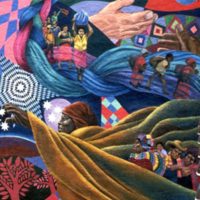
Sanctuary: the Spirit of Harriet Tubman
In 1986, muralist David Fichter created a mural on the side of the Paul Robeson Theatre in Atlanta, Georgia. The mural was sponsored by the city of Atlanta, and depicts Harriet Tubman leading slaves to freedom via the Underground Railroad, against a quilted backdrop..
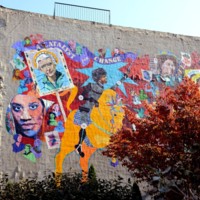
When Women Pursue Justice
In 2005, Artmakers Inc. created a large-scale political mural titled When Women Pursue Justice. During the genesis of the mural, it seemed like an overly ambitious project with little funding, and a heavy reliance on the generosity of its collaborators. Located in Brooklyn, at the busy intersection between Nostrand and Greene Avenue, the mural is populated with women who worked towards justice and social change over the last 150 years. The most visually noticeable figure on the mural is the thirty-five-foot image of Shirley Chisholm astride a golden horse and dressed in armour of African mud and kente cloth. Surrounding Chisholm are 90 women who risked their lives and liberty to achieve voting rights, civil rights, racial justice, health and reproductive rights, and environmental justice and protection – including the abolitionists Harriet Tubman and Sojourner Truth, as well as Angela Davis, Wilma Mankiller, Margaret Sanger, and Dorothy Day.
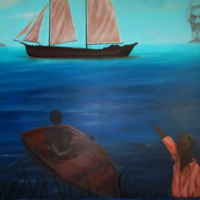
Underground Railroad
In 2012, Mexican muralist Luis Zarate created the mural Underground Railroad on Bay Street in Sodus Point, Wayne County in upstate New York. Sponsored by the Neighborhood Association of Sodus Point, the mural depicts the involvement of Sodus Point in the Underground Railroad of the 1850s. Captain George Garlock, who captained the ship Free Trader out of Sodus Point and picked up runaway slaves on his way to Canada, is depicted in the centre of the mural on the boat between the black antislavery leaders Harriet Tubman and Frederick Douglass. On July 14, 2012, a dedication ceremony revealed a plaque was mounted below the mural that reads: “This mural depicts a scene of the Underground Railroad. From stories passed down there were several safe houses in this area that were used to harbor 'Freedom Seekers.' These included the old Cohn Farm and the old Sodus Fruit Farm and what is now Maxwell Creek B & B and Silver Waters B & B. Sometimes a schooner, out of the old Sodus Point ore dock, would pick up slaves on its way to Canada."
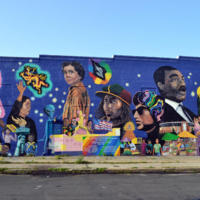
A Little Help From Our Friends
In 2008, Baltimore Green Construction and Rebuilding Together Baltimore contacted Dr. Bob Hieronimus. They asked him to participate in a renovation project throughout the city, including a complete recreation of the 1996 mural A Little Help from Our Friends. The mural is located at Johns Hopkins University’s Office of Volunteer Services and features the faces of Gandhi, Jackie Robinson, Bob Marley, Bob Dylan, Rev. Martin Luther King Jr., and the abolitionist Harriet Tubman, among others. In 1996, the mural won the best mural award from WMAR-TV and was visited by Bob Marley’s sons, Ziggy and Stephen.
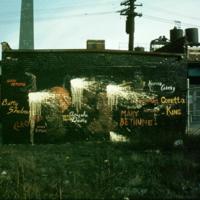
Racism
In 1970, a mural titled Racism appeared in the Cabrini-Green Housing Projects in Chicago’s southside. It celebrated black women who had been key participants in the struggle for black liberation. The mural depicted the faces of Nina Simone, Angela Davis and Kathleen Cleaver, along with the names of Aunt Jemima, Betty Shabazz, Cleopatra, Mary McLeod Bethune, Coretta Scott King and the abolitionist Sojourner Truth. The mural was defaced with white paint shortly after its completion.
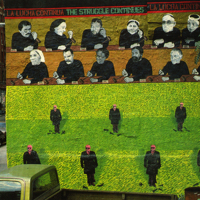
The Last Judgement
This mural, part of a wider series called La Lucha Continua/The Struggle Continues, is split into two halves. The bottom half shows anonymous arms merchants in suits, and the top portrait shows portraits of local residents alongside the leaders Nelson Mandela, Daniel Ortega, Robert F. Williams and the abolitionist Harriet Tubman, among others.
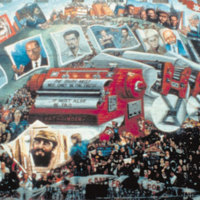
Pathfinder Mural
In 1988, Mike Alewitz designed and began to direct the creation of Pathfinder Mural in New York City’s West Village. The mural, measuring 79 x 85 feet, was an international collaboration of 80 artists from 20 different countries including Argentina, Canada, Iran, New Zealand, Nicaragua and South Africa. At its dedication, it was hailed as one of the largest political murals in the world. In 1987, Alewitz had approached the leaders of the Socialist Workers Party (SWP), of which he was a member, and proposed that Pathfinder Press sponsored a mural for its Charles Street building. The party approved both the project and his concept of the mural: a celebration of the revolutionary struggles in Cuba, Grenada, Nicaragua and South Africa, as well as in America. The central image of the mural is a large red printing press. The faces of Fidel Castro, Che Guevara, Malcolm X, Karl Marx, and Nelson Mandela loop around it. The abolitionists Frederick Douglass, Harriet Tubman and Sojourner Truth also feature. During the creation of Pathfinder Mural, the National Endowment for the Arts withdrew funding from several controversial projects, prompting a debate on free speech and censorship. For the first few months of this mural's creation, work continued without incident. But in 1989, Patrick Buchanan, a conservative commentator, vilified the mural in the Washington Times, calling it a “six-story shrine to communism, a Marxist Mount Rushmore in Greenwich Village." As the mural neared completion, the dialogue between Alewitz and the SWP started to break down. Alewitz was blocked from attending the mural dedication ceremony on November 19, 1989. During December, vandals threw glass bottles filled with white paint at the mural. In 1996, the mural was removed in order to repair cracks in exterior wall of the Pathfinder building, and by 2003, the building on which Pathfinder Mural was housed was sold for around $20 million.
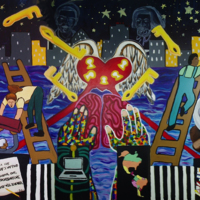
Picturing Our Dreams
Picturing Our Dreams is by incarcerated youth at the Monroe Correctional Facility in Rochester, New York. The mural was created in collaboration with a New York State Library Centre writer, visual artist and Rochester School District teachers. The ideology behind the mural was that inmates could communicate the idea that there is freedom and knowledge inside the jail system. In the centre of the mural, a heart with many key-holes floats around the corresponding keys, and above are the faces of the abolitionists Harriet Tubman and Frederick Douglass, as well as Barack Obama and Dr. Martin Luther King Jr.
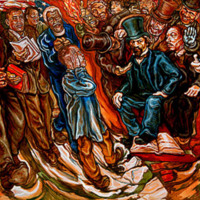
Wall of Black Heroes
In 2006, muralist Joseph Tiberino, along with his sons Gabe and Raphael, painted Wall of Black Heroes for the African American Museum of Philadelphia. When creating the mural, the idea was to provide a portable piece of work that would later be housed in the streets. Measuring 4ft by 12ft, the mural was created on such a scale so as to provide the audience with the sense that the figures of history were life-size. The mural takes the audience on a historical journey, starting with a self-emancipating shackled slave, then moving to the abolitionists Frederick Douglass andHarriet Tubman, then Angela Davis and Malcolm X, Spike Lee, Paul Robeson, Louis Armstrong and Martin Luther King Jr. The mural is now on the side of the Municipal Services Building next to City Hall.
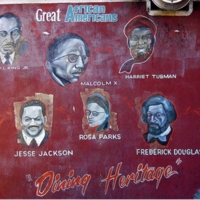
Great African Americans
An unknown artist painted this mural in Harlem, New York City, on the facade of Dining Heritage. It depicts the abolitionists Frederick Douglass and Harriet Tubman, as well as Martin Luther King Jr., Rosa Parks, Jesse Jackson and Malcolm X. It was destroyed in 2015.